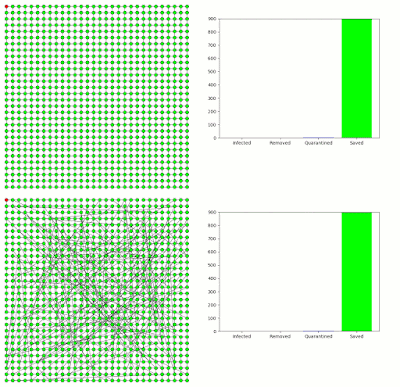Long-distance dispersal boosts Xylella epidemics
Outbreaks of a plant disease in a landscape can be meaningfully modelled using networks with nodes representing individual crop-fields, and edges representing potential infection pathways between them. Their spatial structure, which resembles that of a regular lattice, makes such networks fairly robust against epidemics. Yet, it is well-known how the addition of a few shortcuts can turn robust regular lattices into vulnerable ‘small world’ networks. Although the relevance of this phenomenon has been shown theoretically for networks with nodes corresponding to individual host plants, its real-world implications at a larger scale (i.e. in networks with nodes representing crop fields or other plantations) remain elusive. Focusing on realistic spatial networks connecting olive orchards in Andalusia (Southern Spain), the world’s leading olive producer, we show how even very small probabilities of long distance dispersal of infectious vectors result in a small-world effect that dramatically exacerbates a hypothetical outbreak of a disease targeting olive trees (loosely modelled on known epidemiological information on the bacterium Xylella fastidiosa, an important emerging threat for European agriculture). More specifically, we found that the probability of long distance vector dispersal has a disproportionately larger effect on epidemic dynamics compared to pathogen’s intrinsic infectivity, increasing total infected area by up to one order of magnitude (in the absence of quarantine). Furthermore, even a very small probability of long distance dispersal increased the effort needed to halt a hypothetical outbreak through quarantine by about 50% in respect to scenarios modelling local/short distance pathogen’s dispersal only. This highlights how identifying (and disrupting) long distance dispersal processes may be more efficacious to contain a plant disease epidemic than surveillance and intervention concentrated on local scale transmission processes.
Strona, G., Castellano C., Fattorini S., Ponti L., Gutierrez A.P., Beck P.S.A., 2020. Small world in the real world: long distance dispersal governs epidemic dynamics in agricultural landscapes. Epidemics, https://doi.org/10.1016/j.epidem.2020.100384 | Open access
Strona, G., Castellano C., Fattorini S., Ponti L., Gutierrez A.P., Beck P.S.A., 2020. Small world in the real world: long distance dispersal governs epidemic dynamics in agricultural landscapes. Epidemics, https://doi.org/10.1016/j.epidem.2020.100384 | Open access
 |
| Adding random connections (long-distance dispersal) between nodes (olive orchards) can dramatically boost the progression of infection (Xylella fastidiosa). |

Comments
Post a Comment